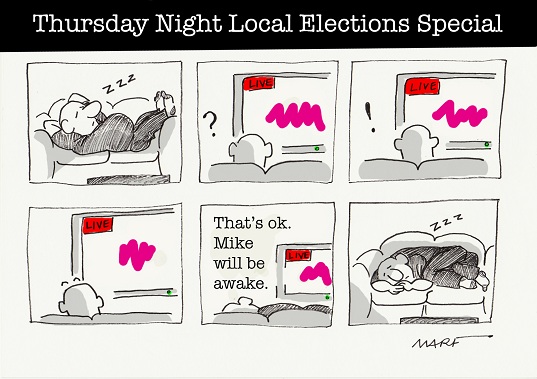The PB Thursday night local elections special

Harry Hayfield previews the contests
Gainsborough East on West Lindsey (Lib Dem defence)
Last Council Election (2011): Con 21, Lib Dem 11, Ind 3, Lab 2 (Conservative majority of 5)
Last Election Result (2011): Lib Dem 1,532 (57%) Con 745 (28%) Lab 422 (16%)
West Lindsey is in the heart of the Lincolnshire Wolds and as such you would expect it to be a Conservative bastion (indeed the parliamentary constituency of Gainsborough is one of the safest Conservative seats in the country) but this actually belies the fact that West Lindsey has been quite the volatile council of late.
Back in 2003 (when the Conservatives had a 5% lead in the national projected vote share) and when the Conservative domination of Gainsborough constituency was just as strong as ever, West Lindsey was in a state of No Overall Control. The Conservatives had 17 councillors, the Liberal Democrats had 13, with 6 Independents and a Labour.
However, being a third council where one third of the seats were up for election, something strange seemed to be happening to the council. The more Conservative the nation became in terms of national vote share, the less Conservative West Lindsey became.
They gained control of the council in 2004, lost control in 2006, saw it go to the Lib Dems in 2007, gained it back in 2008 but have never been able to control it with more than a few seats over the winning line ever since. So Eastleigh is not the only by-election where the coalition partners will be at each other’s throats which poses the question will Labour be able to benefit or will UKIP have the biggest smile on their faces come Friday morning?
Rutherglen South on South Lanarkshire (SNP defence)
Last Council Election (2012): Lab 33, SNP 28, Con 3, Ind 2, Lib Dem 1 (No Overall Control, Labour short by 1)
Last Election Result (2012): Lab 2,095 (44%) Lib Dem 1,181 (25%), SNP 1,141 (24%), Con 232 (5%), Others 130 (3%). One Lab, One Lib Dem, One SNP elected
Although from Wales, the only thing I know about Scottish local elections is that the Independents rule the roost in the Highlands and that thanks to the Single Transferable vote the Labour domination of the central belt is history. Therefore there is only one thing I can do for this and that is defer to the greater knowledge of Kristopher Keane and his review of Rutherglen South that can be found at his blog about Scottish by-elections
Dawley Magna on Telford and the Wrekin (Lab defence)
Last Council Election (2011): Lab 33, Con 17, Lib Dem 3, Ind 1 (Labour majority of 12)
Last Election Result (2011): Lab 3,519 (53%) Ind 2,167 (33%) Con 917 (14%)
When I used to live in Welshpool, on the border between England and Wales, we picked up an expression “going around the Wrekin†which meant “having to do things in a very round about wayâ€. For the Conservatives on Telford and the Wrekin council, that has been the story of their life.
At the 2003 local elections, Labour won control of the council (Lab 29, Con 13, Ind 6, Lib Dem 6), however in 2007 (at the low point for Labour in the local election cycle) Labour lost control of the council but the Conservatives failed to gain control (Con 25, Lab 19, Ind 7, Lib Dem 3) so as you can expect having seen the majority in the Telford constituency plummet to under 1,000 votes and winning the Wrekin constituency handsomely, the Conservatives must have felt very chipper about their prospects for the local elections in 2011.
Sadly, that was to for naught as Labour retook control (Lab 33, Con 17, Lib Dem 3, Ind 1), so therefore as you can see to suggest that the Conservatives will win this ward is perhaps one Wrekin too far.
Perton East on South Staffordshire (Con defence)
Last Council Election (2011): Con 42, Ind 5, Lab 2 (Conservative majority of 35)
Last Election Result (2011): Con 432 (52%) Ind 402 (48%)
South Staffordshire, as well as being famous as being one of the constituencies not to hold a general election on election day, is also renowned for being so solidly Conservative as to be called a one party state. In the 2003 local elections, they had a majority of 21 (Con 35, Lab 8, Ind 5, Lib Dem 1), by 2007 it was 37 (Con 42, Ind 3, Lib Dem 1, Lab 1) and in 2011 you could be tempted to ask “What opposition?â€, however this does not mean that the Conservatives have it all their own way.
In strongly Conservative areas, Independents can put up very strong challenges (as we have seen in past elections in Epsom and Ewell) and in recent by-elections, so can the Independent here take what is a very marginal ward from the Conservatives or will the other parties emboldened by the drop in support for the Conservatives since the general election think they have a chance. That is a question for the electors of Perton East to decide.